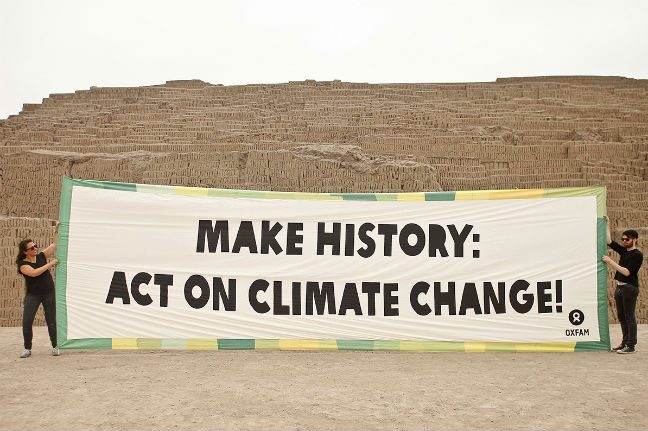
By Frank Boeren, Country Director, Oxfam Peru.
Without a serious commitment to fighting climate change, the world is set for severe, widespread, and irreversible impacts. The impacts of an already rapidly changing climate are being felt all around the world and there’s simply no time left for inaction. This is especially true here in Peru.
That’s why we’re seeing ever-growing pressure for serious global action on climate change. In September over 650,000 people around the world took to the streets and joined the largest ever public mobilisation on climate change – calling for political leaders to make vital, life-saving commitments to act. Now decision makers have the chance to come together and clearly signal their intent to make climate action real.
The UNFCCC’s (United Nations Framework Convention on Climate Change) 20th Conference of the Parties (COP) in Lima, Peru is the next step on the road to securing the ambitious global climate deal we all need. Here we have a breakdown of what you need to know to get up to speed on this crucial climate negotiation.
Where and when?
The conference runs from the 1 — 12 December 2014 in Lima, Peru.
Who’s going to be there?
Delegates from all 196 parties to the 1992 UNFCCC treaty. This group includes all UN member countries (called states) and bodies such as the European Union and the Holy See (the Vatican’s representative).
What’s happening at the COP?
COP20 is a global meeting under the United Nations Framework Convention on Climate Change (the UNFCCC). Parties will discuss key details ahead of the negotiations for a proposed global climate deal at the Paris COP at the end of 2015.
Crucially, COP20 is also a chance for countries to overcome the problems with current climate finance plans. Developed countries have already promised to mobilise $100 billion per year by 2020 to help the world’s poorest countries deal with the effects of climate change.
Right now though, the Green Climate Fund (the system that a large proportion of this money is expected to pass through) is falling way short of this and has seen pledges of less than $10 billion.
Why is this conference so important?
The COP is an opportunity for governments from around the world – rich and poor – to come together to act on climate change.
Climate change is harming food production and increasing hunger right now; things are only set to get worse if we don’t see serious action from world leaders. By 2050, 50 million more people (equivalent to the population of Spain) will be at risk of going hungry because of climate change.
That’s why we need big commitments on climate finance (to help adaptation efforts and dealing with the current effects) and ambitious aims for mitigation (reducing emissions and therefore the impact climate change will have) to be decided in Paris next year.
Why does it matter that Peru is the venue?
Peru is one of the many countries on the front lines of the fight against climate change. Right now over 80% of the production of staple food in Peru is extremely vulnerable to droughts and agricultural production in the whole Andean region could fall between 12 — 50% in the next decades as a result of climate change.
The people of Peru are directly feeling the pressure of our changing climate, bringing the world’s attention to Lima now offers a chance to put the stories of people being affected at the heart of these negotiations.
What can I do?
The COP in Lima is a crucial stepping stone on a path to truly tackling climate change. We need to see real movement on climate finance to deal with the impacts of climate change and real signs that world leaders are going to make 2015 a year of climate action.
You can keep up to date with everything going on at the COP and join in our campaigns by following Oxfam on Twitter, and you can spread the word about how important a moment the Lima COP or by sharing this blog.